
6CO2 + 6H2 O + chlorophyll + sunlight → C6 H12 O6 + 6O2
Photosynthesis takes place inside chloroplasts.
Vacuole is an organelle that is found in many types of cells.
- Water and dissolved substances are in it
- Pushes against the cell wall and keeps the plant rigid
Store of chemical potential energy - food, battery, fuel
Glucose (C6H12O6) is a store of chemical potential energy.
Glucose is soluble in water, which makes it difficult to store inside a cell for storage.
Some of the glucose is changed into a different kind of carbohydrate - starch (a long chain of thousands of glucose molecules linked together) and stored inside the chloroplasts as insoluble grains for storage.

Variegated leaf - leaf with different colored spots
→ Put the leaf in boiling water to break down the cell membranes. (Iodine solution can’t get through the cell membranes of the leaf)
→ Remove the leaf from the water.
→ Put the leaf in a test tube containing ethanol and place the test tube in very hot water. Green color(chlorophyll) will come out of the leaf into ethanol. (Ethanolis used as decolorizing agent)
→ Take the leaf out an dput it into water to soften it. And spread the leaf out on a tile.
→ Add iodine solution to the leaf.
* If the leaf contains starch, it will turn blue-black. *

Fertilizers contain mineral salts needed for plants.
There are (2) types of fertilizers.
-Natural fertilizers
-Chemical fertilizers
Dead organic matter can be broken down by decomposers and atoms in them can be reused as mineral salts for plants.
Nitrate and Magnesium are 2 types of mineral salts that plants need.
Nitrate is needed for making chlorophyll and protein.
Nitrate shortage - stunted & turn yellow
Magnesium is needed for making chlorophyll
Magnesium shortage - turn yellow and stunted only after a long time
There are (4) ways that water is useful for plants.

- To support the plant to be strong, firm, and to stand upright.
Note - Loss of water in vacuoles makes the plant wilt.

- To transport water in which mineral salts are dissolved through xylems from the roots to the leaves.
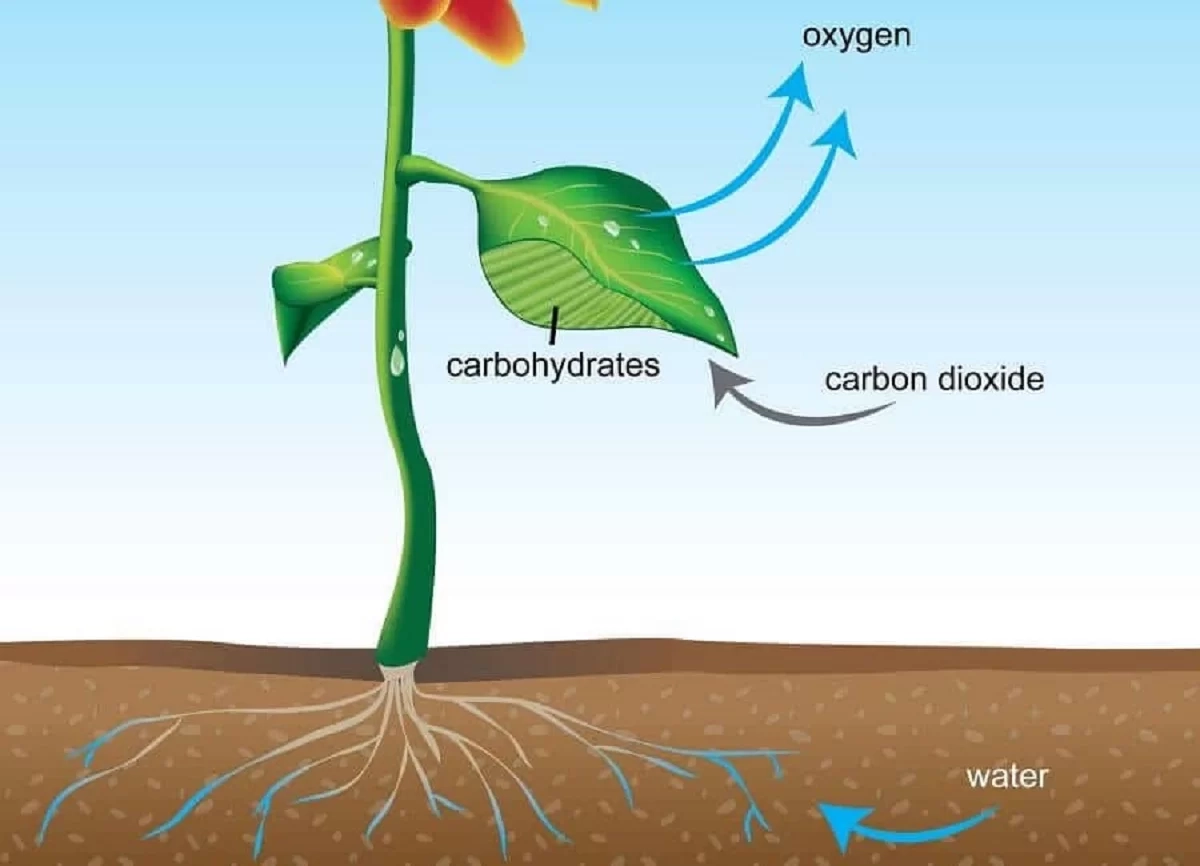
- As one of the reactants in photosynthesis.
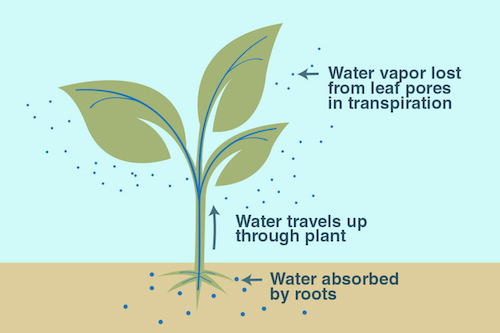
- A way of plants cooling themselves and their surrounding environment which is also called transpiration.
- Loss of water from the vacuole in the form of water vapour through stomata
- Keeps the plant and its surroundings cool
- Around 90% of all the water is used up by transpiration
Transpiration creates transpiration pull which draws water upward from the roots to the leaves through xylems.
Plants drop leaves in summer to reduce greater water loss as there will be less water escaping through transpiration.
Flowers are the reproductive organs of a plant.

Sepal - small leaflike under the flower
Petal - colourful part attracting insects or birds
Receptacle - stem to which floral organs are attached
Stamen / androecium (male reproductive organ)
- Anther (produce pollen)
- Filament
Carpel / gynoecium (female reproductive organ)
- Stigma
- Style
- Ovary
Male gamete is inside the pollen.
Female gamete is inside the ovule which is inside the ovary.
Flower that has both male and female reproductive parts - bisexual flower
Flower that has only male or female reproductive parts - unisexual flower.(eg - papaya, maze)
* Most of the flowers are bisexual.*
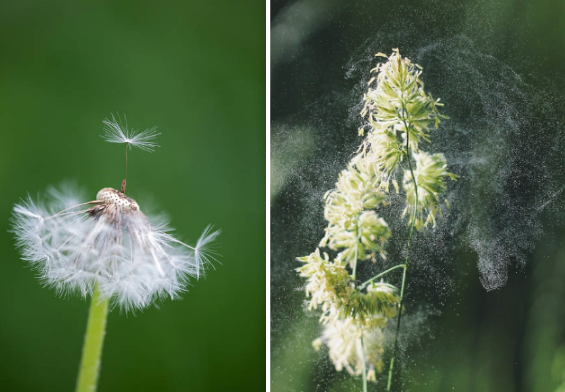
The transfer of pollen from an anther to a stigma is called pollination.
Pollination is done by external agents, and matchmakers, such as wind, bees, butterflies, birds, insects, and even humans.
Plants that rely on the wind in order to pollinate tend to have flowers that contain thousands of extremely tiny and lightweight pollen grains.
(2) types of pollination
- Self-pollination
- Cross-pollination
Self-pollination occurs when the pollen from the anther is transferred on the stigma of the same flower or another flower on the same plant.
Cross-pollination is the transfer of pollen from the anther of one flower to the stigma of another flower on a different individual of the same species.
The nucleus of a male gamete and the nucleus of a female gamete joining together is called fertilisation.
Angiosperms (flowering plants) can do both sexual and asexual reproduction.
Asexual reproduction - vegetative propagation
Diploid cell - 2 complete sets of chromosomes
Haploid cell - only a single set of chromosomes
Mitosis - a type of cell division with the same number of chromosomes as the parent cell and produces 2 diploid daughter cells.
Meiosis - a type of cell division with half the number of chromosomes of the parent cell and produces 4 haploid daughter cells.
Megaspore, mother cell, undergoes meiosis and produces 4 haploid daughter cells.
3 of them degenerate.
1 surviving megaspore expands and undergoes 3 rounds of mitosis and produces 8 haploid nuclei which share only 1 cytoplasm.
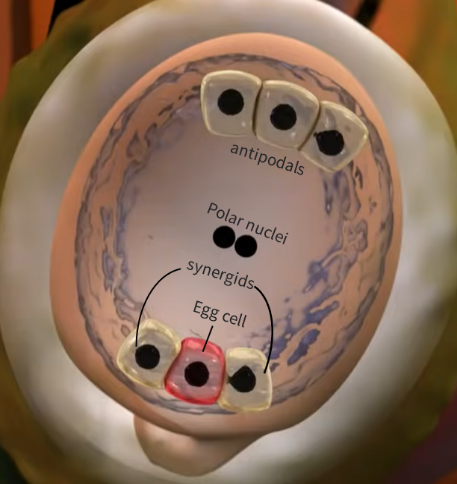
Cell walla form between most of the nuclei, antipodals, synergids, and egg cells.
The pollen grain contains two nuclei the generative(male) and tube nucleus.
The tube nucleus controls the growth pollen tube which carries the male gamete toward the ovule through stigma & style.
When pollen grain lands on the stigma, tube cell forms a pollen tube down the style into the ovary. And the generative/sperm nucleus travels along the pollen tube.
The sperm cell is haploid due to pollen grain formation.
Haploid sperm cell produces another 2 haploid nuclei.
One of them fertilises with the egg cell and forms a diploid zygote which will grow as an embryo.
The other one fuses with polar nuclei and forms a triploid cell which will become an endosperm.
The other cells inside the ovule, antipodals, and synergids, degenerate after fertilisation.
Endosperm - embryo’s food supply during early development
The parent diploid cell in the pollen grain undergoes meiosis and produces 4 haploid daughter cells called microspores.
Each microspore undergoes another mitosis and produces the pollen grain containing 2 haploid nuclei, generative, and tube.
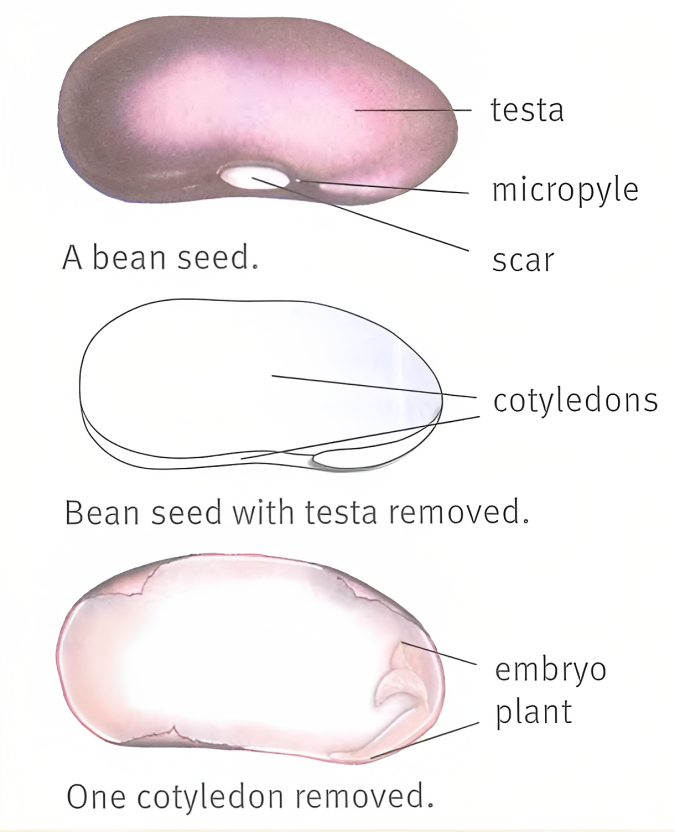
Embryo plant has (2) parts
- Plumule (shoot)
- Radical (root)
Cotyledons contain food stored for the embryo.
1 cotyledon - monocot seed
2 cotyledons - dicot seed
Testa - tough outer coat of the seed
Micropyle - a tiny hole where the pollen tube grows into the ovule
Cotyledons are not needed anymore when the new leaves form and the plant is able to do photosynthesis by itself.
After fertilisation,
Ovule develops into a seed.
Ovary develops into a fruit.

The young plant needs to be dispersed away from the parent plant because it won’t be able to get enough water, light, or mineral salts when they grow up as it will have to compete with the parent plant.
They can be dispersed away by
- Being carried off away by the animals
- Being blown away by the wind
- Floating away on the water